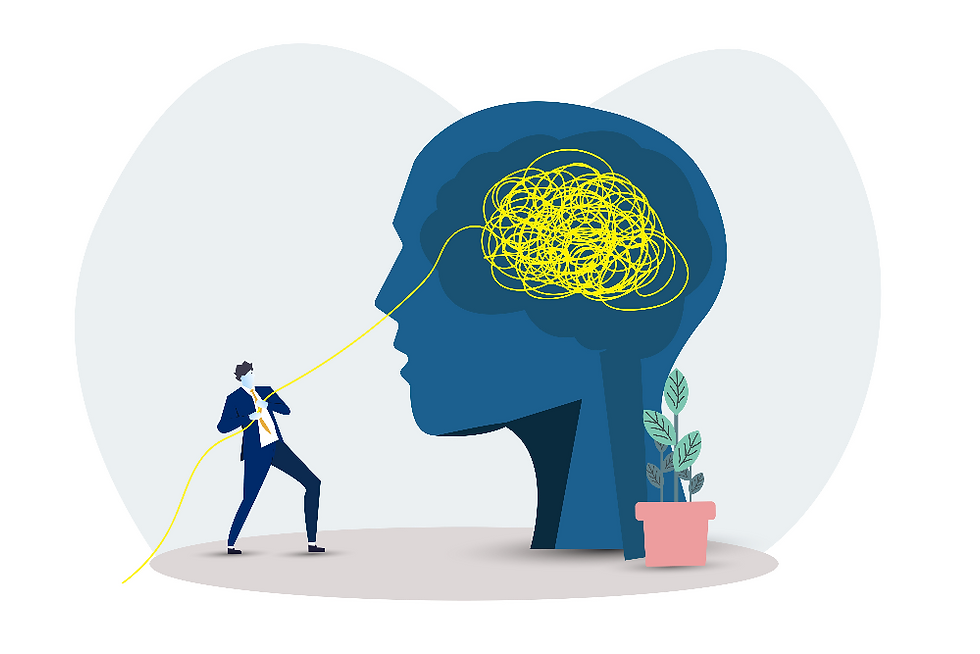What is Cognitive Behavioral Therapy (CBT)?
- Paul Dixon

- Jun 20, 2024
- 3 min read
Updated: Jun 30, 2024
We are conscious of our own existence. As such, we have the ability to hold a conversation with ourselves, just as two people would. We refer to this as our inner voice. This is why I started this section with 'I think, therefore I am.' This ability is the foundation of CBT.
The inner dialogue or "inner voice" is a fascinating aspect of human cognition. It's like having a conversation with ourselves, a process often referred to as self-talk. This inner dialogue plays a significant role in various psychological theories and therapies, including Cognitive Behavioral Therapy (CBT).
Descartes' famous proposition "I think, therefore I am" ("Cogito, ergo sum" in Latin) highlights the fundamental concept of self-awareness. Our ability to think, reason, and reflect on our own thoughts is what makes us conscious beings, aware of our existence.

In CBT, this inner dialogue is central. It's about recognizing and understanding the thoughts, beliefs, and interpretations we have about ourselves, others, and the world around us. By becoming aware of these thoughts, we can evaluate their accuracy and challenge any negative or unhelpful patterns. Through this process, individuals can develop healthier ways of thinking and responding to challenging situations, ultimately leading to improved emotional well-being.
Cognitive Behavioral Therapy (CBT) is a widely practised and evidence-based form of psychotherapy that focuses on the relationship between thoughts, emotions, and behaviours. It's based on the idea that our thoughts and interpretations of events influence how we feel and behave. Developed by Aaron Beck and Albert Ellis in the 1960s, CBT has since become one of the most widely used therapeutic approaches for treating various issues.
Here's an overview of key components and techniques used in CBT:
Cognitive Restructuring: This involves identifying and challenging negative or distorted thought patterns (cognitive distortions) that contribute to emotional distress. Clients learn to recognize these thoughts, evaluate their accuracy and validity, and develop more balanced and realistic perspectives.
Behavioural Activation: This focuses on increasing engagement in rewarding and pleasurable activities to improve mood and motivation. Clients learn to identify and schedule enjoyable activities that promote a sense of accomplishment and fulfilment, even when they may not feel like it initially.
Exposure Therapy: Used primarily in the treatment of anxiety disorders, exposure therapy involves gradually and systematically confronting feared situations or stimuli in a safe and controlled environment. Through repeated exposure, individuals learn to reduce their fear and anxiety responses.
Problem-Solving Skills: Clients learn practical strategies for identifying problems, generating potential solutions, and implementing effective coping strategies. This helps individuals develop a sense of mastery and control over challenging situations.
Relaxation Techniques: Various relaxation techniques, such as deep breathing, progressive muscle relaxation, and mindfulness meditation, are often incorporated to help reduce physiological arousal and promote a sense of calmness and well-being.
Homework Assignments: Clients are often given homework assignments between therapy sessions to practice and reinforce skills learned in therapy. These assignments help individuals apply therapeutic techniques in real-life situations and facilitate ongoing progress outside of therapy sessions.
Collaborative and Goal-Oriented Approach: CBT is a collaborative process between the therapist and client, focusing on setting specific, measurable, achievable, relevant, and time-bound (SMART) goals. Clients actively participate in setting treatment goals and monitoring progress throughout therapy.

Overall, CBT is a highly structured and practical approach that emphasizes the importance of changing both cognitive patterns and behaviours to alleviate psychological distress and improve overall well-being. So, indeed, our inner voice is a powerful tool that influences our perceptions, emotions, and behaviours, and understanding and managing it effectively can be transformative in promoting mental health and well-being.
If you have found this post of value and wish to show your support for my efforts, you can consider treating me to a coffee. Your support enables me to keep offering valuable insights and tips. Thank you! Don't hesitate to reach out if you have any questions or require additional assistance. I am available to assist you!
